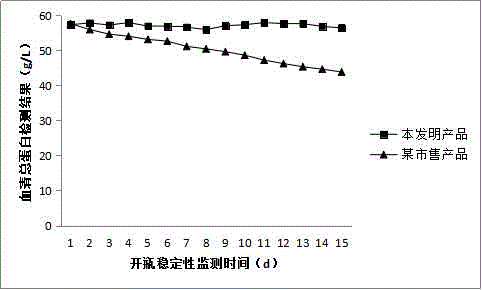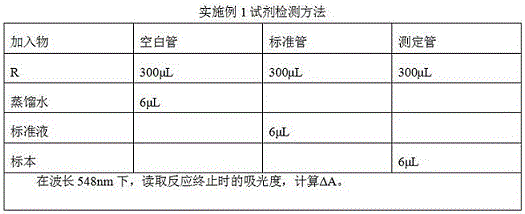Total serum protein detection kit with strong anti-interference capability
A detection kit and total protein detection technology, which is applied in the field of serum total protein detection, can solve the problems of expensive antibody, slow color development, and not widely used, and achieve the effect of good repeatability, simple operation, and good accuracy
- Summary
- Abstract
- Description
- Claims
- Application Information
AI Technical Summary
Problems solved by technology
Method used
Image
Examples
Embodiment 1
[0033] Reagent R composition:
[0034] Copper sulfate pentahydrate 3g / L
[0035] Potassium iodide 5g / L
[0036] Sodium Potassium Tartrate 18g / L
[0037] Potassium hydroxide 8.0g / L
[0038] Tween-20 0.8%
[0039] Polyoxyethylene lauryl ether 5g / L
[0040] EDTA·Na 2 6.7g / L
[0041] Urea 4.6g / L
[0042] Triton x-100 0.1%
[0043] The usage method of embodiment 1 reagent:
[0044] The serum total protein detection reagent described in this example is used in a fully automatic biochemical analyzer, such as Hitachi 7180 fully automatic analyzer, etc., and is measured by the one-point endpoint method. Set the ratio of sample and reagent R to 6:300, place distilled water, standard and sample in the corresponding position of the sample plate, the operation is as follows image 3 .
[0045] Urinary total protein content (g / L) = (∆A measurement ÷ ∆A standard) × C standard.
Embodiment 2
[0047] Interference test: Take fresh mixed urine, divide it into 2 equal parts, then divide each part into 5 equal parts, according to Figure 4 The concentration requires adding different interfering substances, and then use the reagents obtained in Example 1 to compare and measure the content of total urinary protein with the common and recognized urine total protein reagents in the market. See the test results Figure 4 . Relative deviation (%) = (measuring mean value of interference samples - measuring mean value of control samples) / measured mean value of control samples × 100%.
[0048] Depend on Figure 4 It can be seen that the test results of the reagent of Example 1 are dextran≤100g / L, bilirubin≤100mg / L, calcium ion≤4mmol / L, magnesium ion≤5mmol / L, triglyceride≤22.6mmol / L No apparent interference. Consistent with the test results of the control reagent, it shows that the reagent of Example 1 is up to the standard in accuracy, and the anti-interference ability is ob...
Embodiment 3
[0050] Correlation experiment: using the formula in Example 1 to prepare reagents, and conducting a control test with the serum total protein kit of a company approved by the State Food and Drug Administration, which is common in the market, and testing 20 clinical serum samples at the same time, the test results are as follows: Figure 5 shown. And obtained the correlation curve of the two reagents (such as figure 1 As shown), the test results show that the correlation coefficient of the two kits is 0.999, indicating that there is a great correlation between the two.
[0051] The calibrators and quality controls used in the test were:
[0052] RANDOX938 calibrator: the content of total serum protein is 63.0g / L;
[0053] RANDOX1005 quality control substance: the target value of serum total protein is 59.3g / L, and the target value range: 47.5-71.1g / L.
PUM
 Login to View More
Login to View More Abstract
Description
Claims
Application Information
 Login to View More
Login to View More - R&D
- Intellectual Property
- Life Sciences
- Materials
- Tech Scout
- Unparalleled Data Quality
- Higher Quality Content
- 60% Fewer Hallucinations
Browse by: Latest US Patents, China's latest patents, Technical Efficacy Thesaurus, Application Domain, Technology Topic, Popular Technical Reports.
© 2025 PatSnap. All rights reserved.Legal|Privacy policy|Modern Slavery Act Transparency Statement|Sitemap|About US| Contact US: help@patsnap.com



